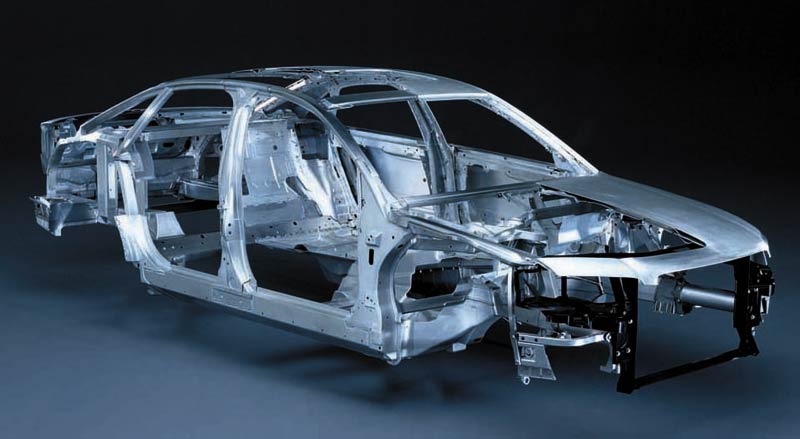
What car bodies are made of
Content
When developing a new car model, each manufacturer seeks to increase the dynamics of its products, but at the same time not to deprive the car of safety. Although the dynamic performance largely depends on the type of engine, the body of the car plays a significant role. The heavier it is, the more efforts the internal combustion engine will make in order to accelerate the transport. But if the car is too light, it will often negatively affect the downforce.
By making their products lighter, manufacturers strive to improve the aerodynamic properties of the body (what aerodynamics is, is described in another review). Reducing the weight of the vehicle is carried out not only through the installation of units made of light-alloy materials, but also thanks to lightweight body parts. Let's figure out what materials are used to make car bodies, as well as what are the pros and cons of each of them.
Prehistory of car bodies
The body of a modern car is given no less attention than its mechanisms. Here are the parameters it must meet:
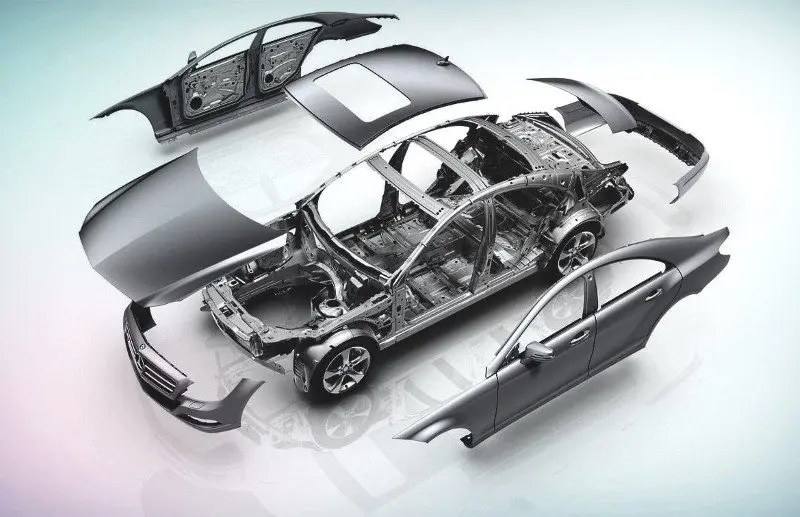
- Lasting. In a collision, it must not injure people in the passenger compartment. The torsional rigidity should ensure that the car remains in shape when driving over uneven terrain. The smaller this parameter is, the more likely it is that the car frame is deformed, and the transport will be unsuitable for further operation. Particular attention is paid to the strength of the front of the roof. The so-called "moose" test helps the automaker determine how safe the car will be when hitting a tall animal, such as a deer or elk (the entire mass of the carcass falls on the windshield and the upper lintel of the roof above it).
- Modern design. First of all, sophisticated motorists pay attention to the shape of the body, and not only to the technical part of the car.
- Safety. Everyone in the vehicle must be protected from external influences, including in a side collision.
- Versatility. The material from which the car body is made must withstand different weather conditions. In addition to aesthetics, paintwork is used to protect materials that are afraid of aggressive moisture.
- Durability. It is not uncommon for the creator to save on body material, which is why the car becomes unusable after just a few years of operation.
- Maintainability. So that after a minor accident you don't have to throw the car away, the manufacture of modern body types implies modular assembly. This means that the damaged part can be replaced with a similar new one.
- Affordable price. If the car body is made of expensive materials, a huge number of unclaimed models will accumulate at the sites of automakers. This often happens not because of poor quality, but because of the high cost of vehicles.
In order for a body model to meet all these parameters, manufacturers have to take into account the characteristics of the materials from which the frame and outer body panels are made.
So that the production of a car does not require a lot of resources, the engineers of the companies develop such body models that allow combining their main function with additional ones. For example, the main units and interior parts are attached to the car structure.
Initially, the design of the cars was based on a frame to which the rest of the machine was attached. This type is still present in some car models. An example of this is full-fledged SUVs (most jeeps simply have a reinforced body structure, but there is no frame, this type of SUV is called crossover) and trucks. On the first cars, each panel attached to the frame structure could be made not only of metal, but also of wood.
The first model with a frameless load-bearing structure was the Lancia Lambda, which rolled off the assembly line in 1921. The European model Citroen B10, which went on sale in 1924, received a one-piece steel body structure.
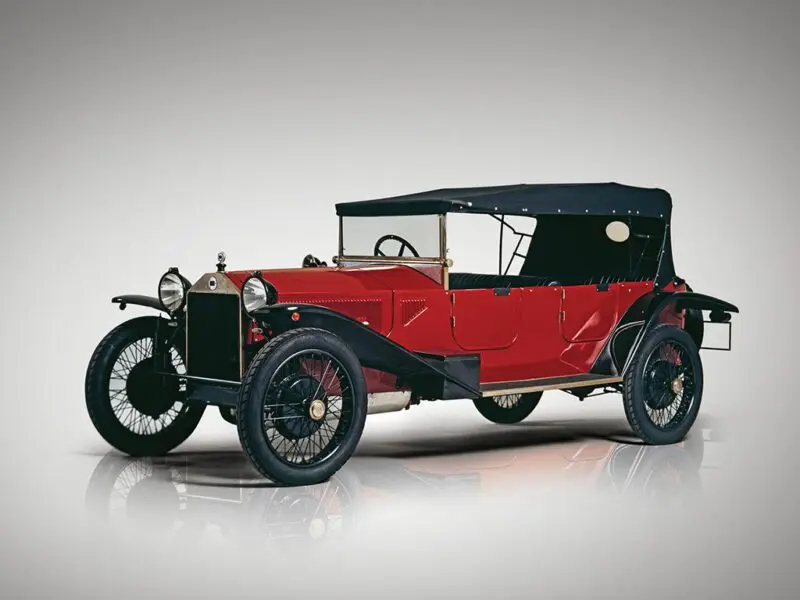
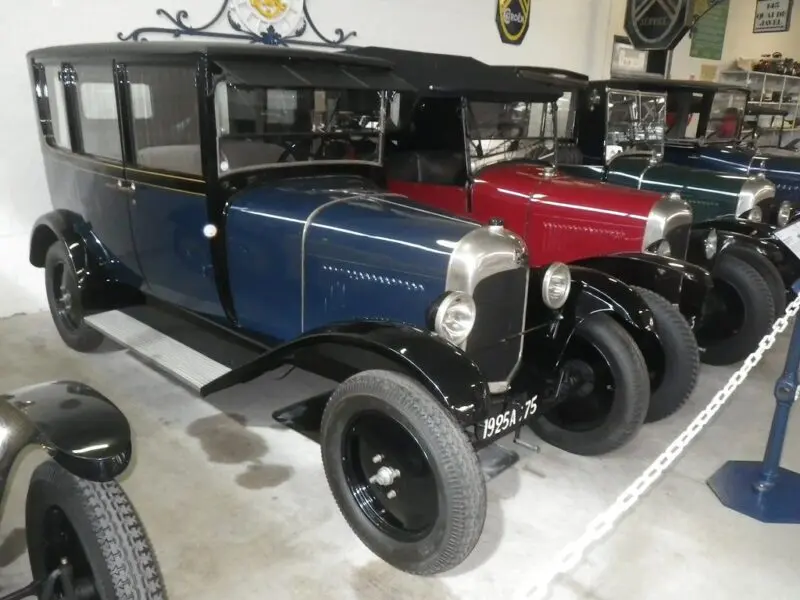
This development proved so popular that most manufacturers of the time rarely abandoned the concept of an all-steel monocoque body. These machines were safe. Some firms rejected steel for two reasons. First, this material was not available in all countries, especially during the war years. Secondly, the steel body is very heavy, so some, in order to install an internal combustion engine with a lower power, compromised in body materials.
During the Second World War, steel was in short supply all over the world, since this metal was completely used for military needs. Out of a desire to stay afloat, some companies have decided to manufacture their body models from alternative materials. So, in those years, cars first appeared with an aluminum body. An example of such models is the Land Rover 1-Series (the body consisted of aluminum panels).

Another alternative is a timber frame. An example of such cars is the Willys Jeep Stations Wagon Woodie modification.

Since the wooden body is not durable and needed serious care, this idea was soon abandoned, but as for aluminum structures, manufacturers seriously thought about introducing this technology into modern production. While the main apparent reason is a lack of steel, this was not really the driving force behind which automakers began looking for alternatives.
- Since the global fuel crisis, most car brands have had to rethink their manufacturing technology. First of all, the audience that requires powerful and voluminous motors has sharply decreased due to the high cost of fuel. Motorists began to look for less voracious cars. And in order for transport with a smaller engine to be dynamic enough, a light, but at the same time sufficiently strong material was required.
- All over the world, over time, environmental standards for vehicle emissions have become more stringent. For this reason, a technology has begun to be introduced to reduce fuel consumption, improve the quality of combustion of the air-fuel mixture and increase the efficiency of the power unit. To do this, you need to reduce the weight of the entire car.
Over time, developments in composite materials appeared, which made it possible to further reduce the weight of vehicles. Let's consider what is the peculiarity of each material that is used for the manufacture of car bodies.
Steel body: advantages and disadvantages
Most of the body elements of a modern car are made of rolled steel. The thickness of the metal in some sections reaches 2.5 millimeters. Moreover, low-carbon sheet material is mainly used in the bearing part. Thanks to this, the car is quite lightweight and at the same time durable.
Today steel is not in short supply. This metal has high strength, elements of various shapes can be stamped from it, and the parts can be easily fastened together using spot welding. When manufacturing a car, engineers pay attention to passive safety, and technologists pay attention to the ease of processing the material so that the cost of transport is as low as possible.
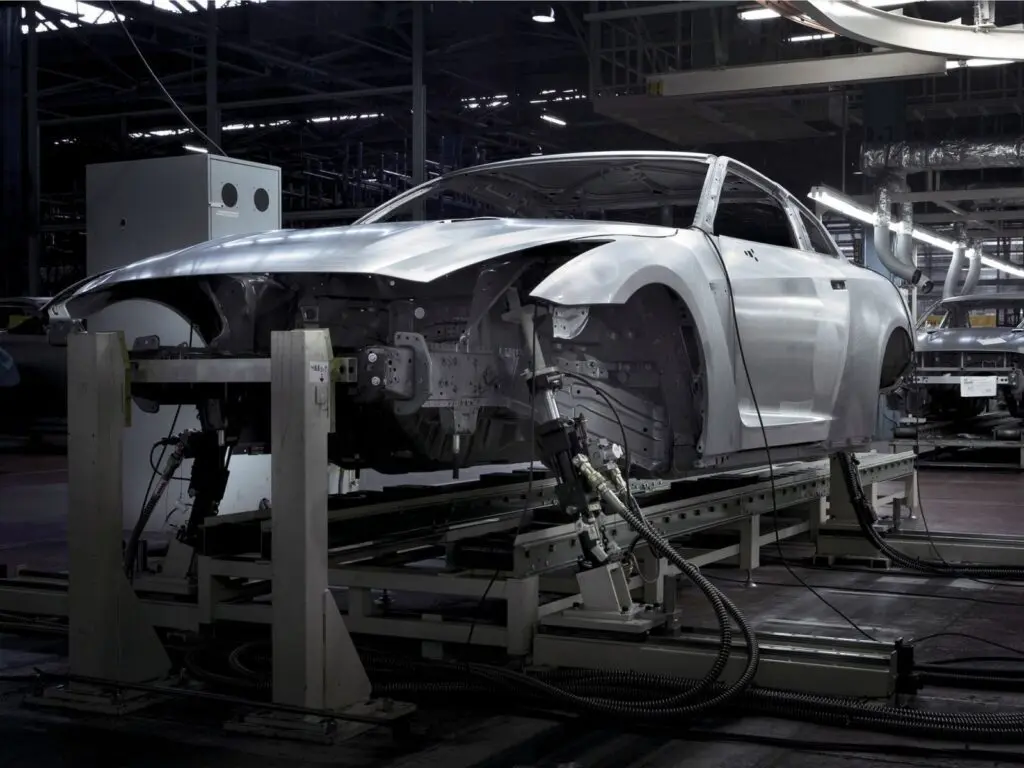
And for metallurgy, the most difficult task is to please both engineers and technologists. With the desired properties in mind, a special grade of steel has been developed that has the ideal combination of drawability and sufficient strength in the finished product. This simplifies the production of body panels and increases the reliability of the car frame.
Here are some more benefits of a steel body:
- Repair of steel products is the easiest - just buy a new element, for example, a wing, and replace it;
- It is easy to recycle - steel is highly recyclable, so the manufacturer always has the opportunity to get cheap raw materials;
- The technology for the manufacture of rolled steel is simpler than the processing of light-alloy analogs, so the raw material is cheaper.
Despite these advantages, steel products have several significant disadvantages:
- Finished products are the heaviest;
- Rust quickly appears on unprotected parts. If the element is not protected with paintwork, damage will quickly render the body unusable;
- For sheet steel to have increased rigidity, the part must be stamped many times;
- The resource of steel products is the smallest in comparison with non-ferrous metals.
Today, the property of steel is increased by adding some chemical elements to the composition, which increase its strength, resistance to oxidation and plasticity characteristics (TWIP steel is capable of stretching up to 70%, and the maximum indicator of its strength is 1300MPa).
Aluminum body: advantages and disadvantages
Previously, aluminum was only used to make panels that were fixed to a steel structure. Modern developments in the production of aluminum make it possible to use the material also for creating frame elements.
Although this metal is less susceptible to moisture than steel, it has less strength and mechanical elasticity. For this reason, to reduce the weight of a car, this metal is used to create doors, luggage racks, hoods. To use aluminum in the frame, the manufacturer has to increase the thickness of the products, which often works against easier transport.
The density of aluminum alloys is much lower than that of steel, so noise insulation in a car with such a body is much worse. To ensure that the interior of such a car receives a minimum of external noise, the manufacturer uses special noise suppression technologies, which makes the car more expensive than a similar option with a steel body.
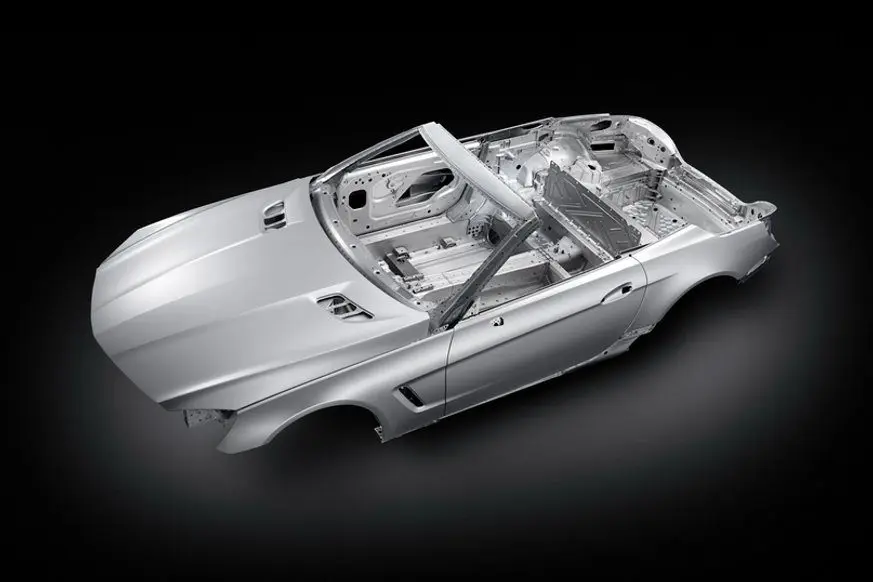
Making an aluminum body in the early stages is similar to the process of creating steel structures. Raw materials are broken into sheets, then they are stamped according to the desired design. Parts are assembled into a common design. Argon welding is used only for this. More expensive models use laser spot welding, special glue or rivets.
Arguments in favor of an aluminum body:
- Sheet material is easier to stamp, therefore, in the process of manufacturing panels, less powerful equipment is required than for stamping from steel;
- Compared to steel bodies, the identical shape made of aluminum will be lighter, while the strength remains at the same level;
- Parts are easily processed and recyclable;
- The material is more durable than steel - it is not afraid of moisture;
- The cost of the manufacturing process is lower compared to the previous version.
Not all motorists agree to buy a car with an aluminum body. The reason is that even with a minor accident, car repairs will be expensive. The raw material itself costs more than steel, and if the part needs to be changed, the car owner will have to look for a specialist who has special equipment for high-quality connection of elements.
Plastic body: advantages and disadvantages
The second half of the twentieth century was marked by the appearance of plastic. The popularity of such a material is due to the fact that any structure can be made from it, which will be much lighter than even aluminum.
Plastic does not need paintwork. It is enough to add the necessary dyes to the raw materials, and the product acquires the desired shade. In addition, it does not fade and does not need to be repainted when scratched. Compared to metal, plastic is more durable, it does not react with water at all, so it does not rust.
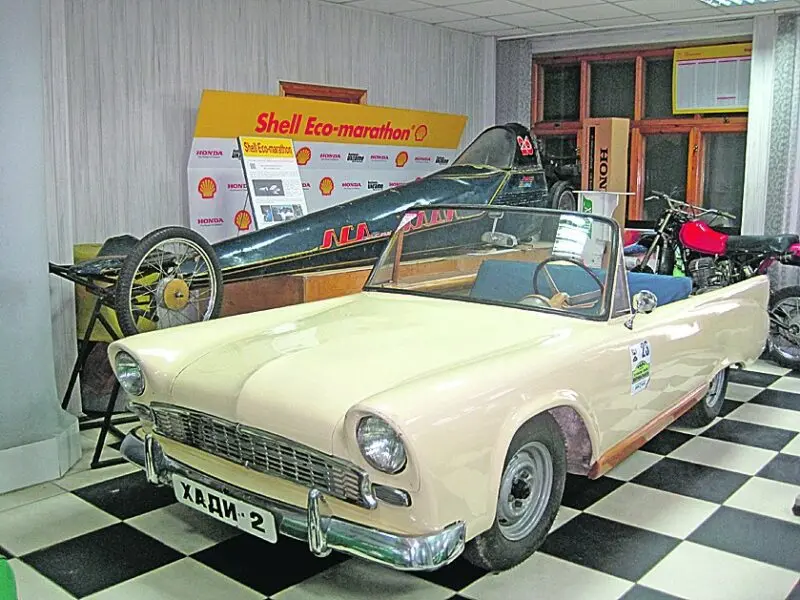
The cost of making plastic panels is much lower, since powerful presses are not needed for embossing. The heated raw materials are fluid, due to which the shape of the body parts can be absolutely any, which is difficult to achieve when using metal.
Despite these clear advantages, plastic has a very big drawback - its strength is directly related to the operating conditions. So, if the outside air temperature drops below zero, the parts become fragile. Even a small load can cause the material to burst or fly to pieces. On the other hand, as the temperature rises, its elasticity increases. Some types of plastics deform when heated in the sun.
For other reasons, plastic bodies are less practical:
- Damaged parts are recyclable, but this process requires special, expensive equipment. The same goes for the plastics industry.
- During the manufacture of plastic products, a large amount of harmful substances is emitted into the atmosphere;
- The load-bearing parts of the body cannot be made of plastic, since even a large piece of material is not as strong as thin metal;
- If the plastic panel is damaged, it can be easily and quickly replaced with a new one, but it is much more expensive than welding a metal patch to metal.
Although nowadays there are various developments that eliminate most of the listed problems, it has not yet been possible to bring the technology to perfection. For this reason, bumpers, decorative inserts, moldings are mainly made of plastic, and only in some car models - fenders.
Composite body: advantages and disadvantages
Composite means a material that contains more than two components. In the process of creating a material, the composite acquires a homogeneous structure, due to which the final product will have the properties of two (or more) substances that make up the raw material.
Often, a composite will be obtained by gluing or sintering layers of different materials. Often, to increase the strength of the part, each separate layer is reinforced so that the material does not peel off during operation.
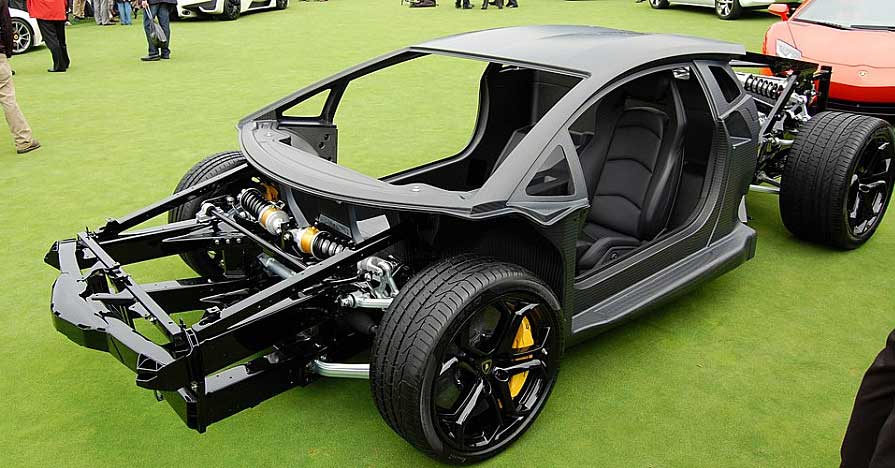
The most common composite used in the automotive industry is fiberglass. The material is obtained by adding a polymer filler to fiberglass. External body elements are made of such material, for example, bumpers, radiator grilles, sometimes head optics (more often they are made of glass, and lightweight versions are made of polypropylene). The installation of such parts allows the manufacturer to use steel in the structure of the supporting body parts, but at the same time keep the model light enough.
In addition to the advantages listed above, the polymer material occupies a worthy place in the automotive industry for the following reasons:
- The minimum weight of the parts, but at the same time they have decent strength;
- The finished product is not afraid of the aggressive effects of moisture and sun;
- Due to the elasticity at the raw material stage, the manufacturer can create completely different shapes of parts, including the most complex;
- Finished products look aesthetically pleasing;
- You can create huge body parts, and in some cases even the entire body, as in the case of whale cars (read more about such cars in separate review).
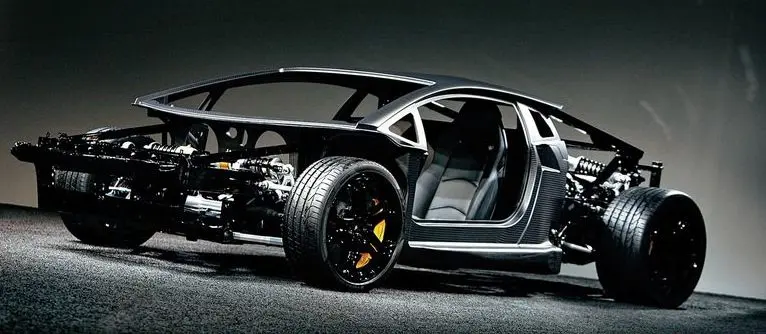
However, innovative technology cannot be a complete alternative to metal. There are several reasons for this:
- The cost of polymer fillers is very high;
- The shape for making the part must be perfect. Otherwise, the element will turn out to be ugly;
- During the manufacturing process, it is extremely important to keep the workplace clean;
- The creation of durable panels is time-consuming, as the composite takes a long time to dry and some body parts are multi-layered. Solid bodies are often made from this material. For their designation, the winged term "monocoque" is used. The technology for creating monocoque body types is as follows. The carbon fiber layer is glued with a polymer. On top of it, another layer of material is laid, only so that the fibers are located in a different direction, most often at right angles. After the product is ready, it is placed in a special oven and kept for a certain time under high temperature so that the material is baked and takes on a monolithic shape;
- When a composite material part breaks down, it is extremely difficult to repair it (an example of how car bumpers are repaired is described here);
- Composite parts are not recycled, only destroyed.
Due to the high cost and complexity of manufacturing, ordinary road cars have a minimum number of parts made of fiberglass or other composite analogs. Most often, such elements are installed on a supercar. An example of such a car is the Ferrari Enzo.

True, some exclusive models of the civilian series receive overall details from a composite. An example of this is the BMW M3. This car has a carbon fiber roof. The material has the necessary strength, but at the same time allows you to move the center of gravity closer to the ground, which increases the downforce when entering corners.
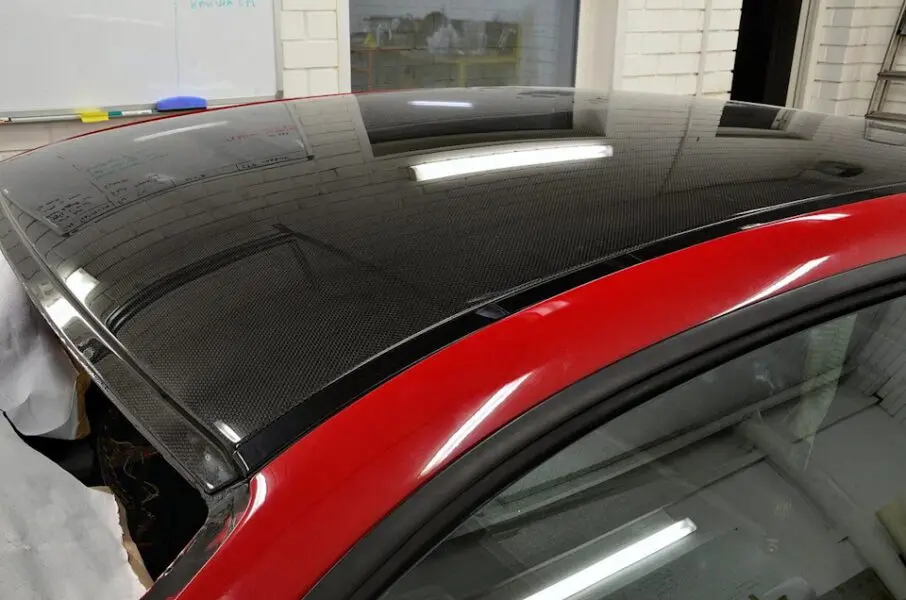
Another original solution in the use of light materials in the body of the car is demonstrated by the manufacturer of the famous supercar Corvette. For almost half a century, the company has been using in the model a spatial metal frame on which composite panels are attached.
Carbon body: advantages and disadvantages
With the advent of another material, the safety and at the same time the lightness of cars has reached a new level. In fact, carbon is the same composite material, only a new generation of equipment allows you to create more durable structures than in the manufacture of monocoque. This material is used in the bodies of famous models such as the BMW i8 and i3. If carbon in other cars was previously used only as a decoration, then these are the first production cars in the world whose body is made entirely of carbon.
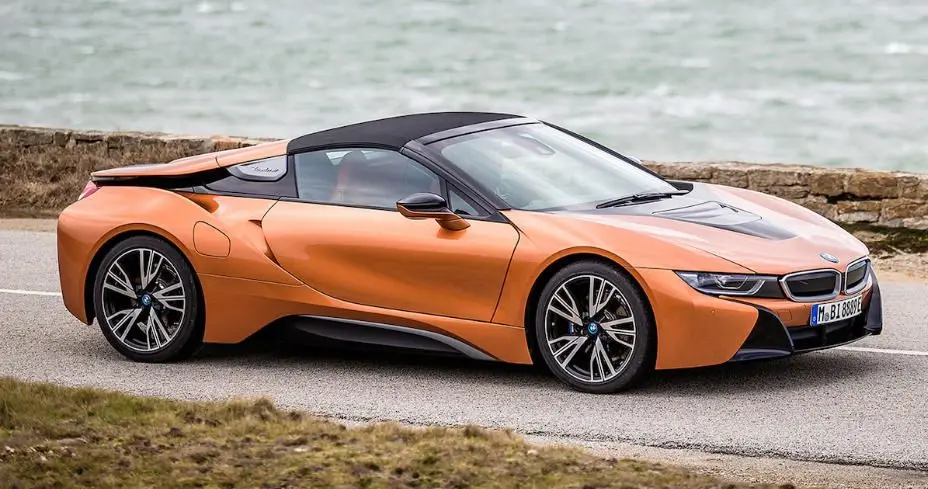
Both models have a similar design: the base is a modular platform made of aluminum. All units and mechanisms of the car are fixed on it. The body of cars consists of two halves, which already have some interior details. They are connected to each other during assembly using bolt clamps. The peculiarity of these models is that they are built on the same principle as the first cars - a frame structure (only as lightweight as possible), on which all other honors are fixed.
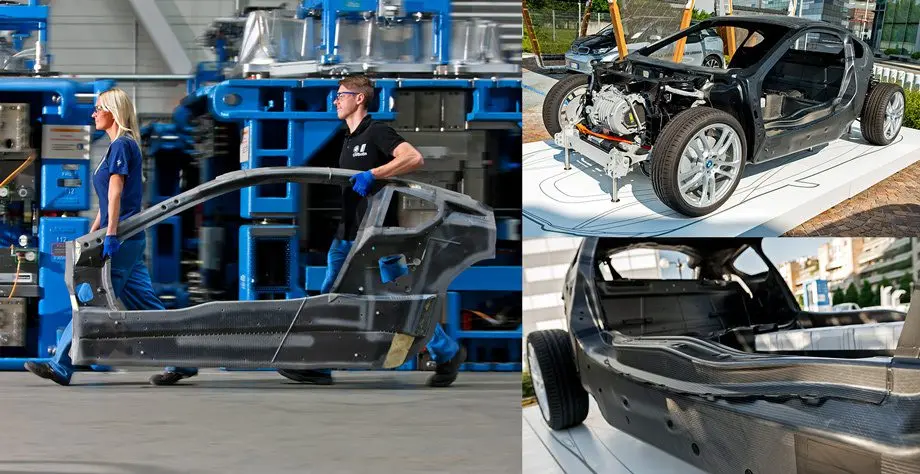
In the manufacturing process, the parts are connected to each other using special glue. This simulates welding metal parts. The advantage of such a material is its high strength. When the car overcomes large irregularities, the torsional rigidity of the body prevents it from deforming.
Another advantage of carbon fiber is that it requires a minimum of workers to manufacture parts, since high-tech equipment is controlled by electronics. The carbon body is made from individual parts that are formed in special shapes. A polymer of a special composition is pumped into the mold under high pressure. This makes the panels more durable than manually lubricating the fibers. In addition, smaller ovens are needed to bake small items.
The disadvantages of such products primarily include the high cost, because expensive equipment is used that needs high-quality service. Also, the price of polymers is much higher than that of the same aluminum. And if the part is broken, then it is impossible to repair it yourself.
Here is a short video - an example of how the carbon bodies of the BMW i8 are assembled:
Questions and answers:
What is included in the car body? The car body consists of: front spar, front shield, front pillar, roof, B-pillar, rear pillar, fenders, trunk panel and hood, bottom.
What is the car body supported on? The main body is the space frame. This is a structure made in the form of a cage, located around the entire perimeter of the body. The body is attached to this supporting structure.

